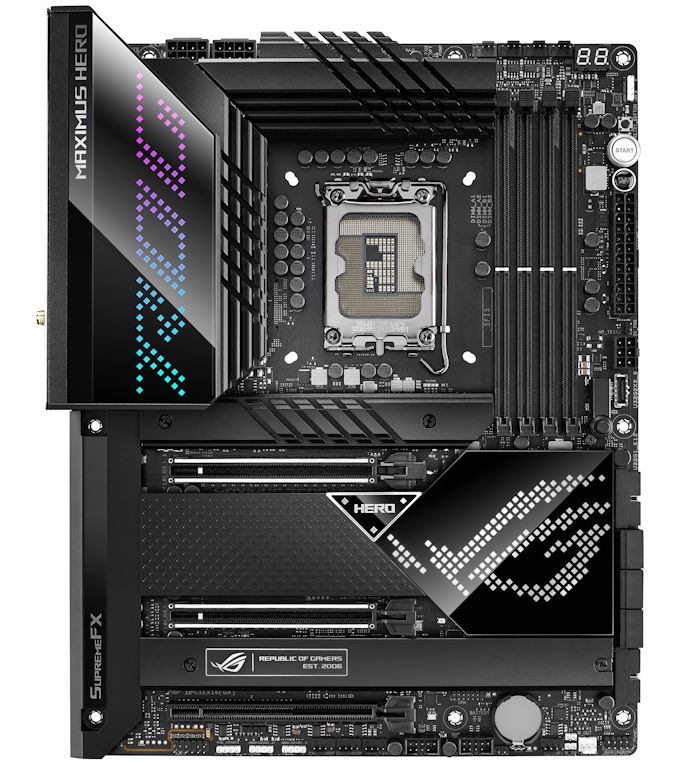The Intel Z690 Motherboard Overview (DDR5): Over 50+ New Models
by Gavin Bonshor on November 9, 2021 9:00 AM ESTASUS ROG Maximus Z690 Hero (DDR5)
Acting as the 'entry-level' if it can be called that to ASUS's ROG Maximus series is the Hero, or the ASUS ROG Maximus Z690 Hero to be exact. Adopting a more futuristic and modern design compared to last year's ROG Maximus XIII Hero, the new Z690 Hero includes its dot matrix display integrated into the rear panel cover and chipset heatsink, which looks fancy and neat. All across the board are oodles of matte black including the M.2 heatsinks, with a central M.2 heatsink that has a black treadplate-looking design on it for contrast.
Looking at the lower half of the board, it is dominated by PCIe slots, including two full-length PCIe 5.0 slots operating at either x16 or x8/x8, with a third full-length PCIe 3.0 x4 slot. Storage options are aplenty including four PCIe 4.0 x4 M.2 slots, with a fifth M.2 slot locked down to PCIe 3.0 x4. Other storage options include six SATA ports that benefit from support for RAID 0, 1, 5, and 10 arrays. Located in the top-right hand corner are four memory slots that are capable of supporting up to DDR5-6400 with a maximum combined capacity of 128 GB.
On the rear panel of the Z690 Hero are a pair of Thunderbolt 4 Type-C ports, with one USB 3.2 G2 Type-C, six USB 3.2 G2 Type-A, and two USB 2.0 ports. Networking options include an Intel I225-V 2.5 GbE controller with an Intel Wi-Fi 6E CNVi offering both wireless and BT 5.2 device connectivity. There are five 3.5 mm audio jacks and S/PDIF optical output powered by a SupremeFX ALC4082 HD audio codec and ESS Sabre 9018Q2C DAC pairing, while the board also has one HDMI 2.1 video output. Finishing off the rear panel is a pair of buttons, one for BIOS Flashback and another to clear the CMOS.












126 Comments
View All Comments
Duwelon - Tuesday, November 9, 2021 - link
Asus' prices are completely bananas. If I build a new rig with Z690 it'll probably be my first non-Asus build in a very long time.Sivar - Tuesday, November 9, 2021 - link
That caught my eye, too. I bought an Asus Hero-branded board for my current system last year at approximately $200 USD.I suspect Asus is shifting their marketspeak because the word "Maximus" (used for the z690 board but not mine) usually applies to their most expensive boards.
blppt - Tuesday, November 9, 2021 - link
This. $2000 for a consumer grade motherboard? WTF are they smoking?Also, I'm pretty sure ASUS will be releasing some TUF Z690s at some point, probably at a lower price point than the primes. My experience with the TUF series has been very positive for the price.
DigitalFreak - Tuesday, November 9, 2021 - link
They know they're not going to sell many of those. Those boards are either for LN2 e-peen competitions or people with more money than sense.Wrs - Wednesday, November 10, 2021 - link
TUF is historically just a bit more expensive than Prime. They already have a TUF DDR4 version - ordered the Wifi one for $290 the other day. If worried about price DDR5 is the first mistake.blppt - Wednesday, November 10, 2021 - link
The X570 TUF was cheaper than the X570 Prime when I went shopping for an AMD board.COtech - Tuesday, November 9, 2021 - link
Subtitle - "Intel Z690 Chipset: Like Z590, But Now With Native PCIe 4.0"I think "But Now With Native PCIe 5.0" is intended.
gavbon - Thursday, November 18, 2021 - link
The Z690 chipset doesn't have PCIe 5.0, this comes from the CPU. The Z690 chipset does, however, now include PCIe 4.0 lanes, whereas Z590 did not.Someguyperson - Tuesday, November 9, 2021 - link
I don't get the "DP IN" ports on the ASUS ProArt Z690 Creator WIFI. I see the author just wrote what was on the ASUS website, but that doesn't really explain anything. Are they passthrough to the Thunderbolt out ports? Is there a capture card built into this motherboard? I'm very confused by the labeling here.uwsalt - Tuesday, November 9, 2021 - link
Those are passthrough to the Thunderbolt port. Add-in Thunderbolt cards work the same way. You slot in your discrete GPU, send the output from both DP ports to the Thunderbolt controller, and then use Thunderbolt to output to a Thunderbolt monitor or hub.